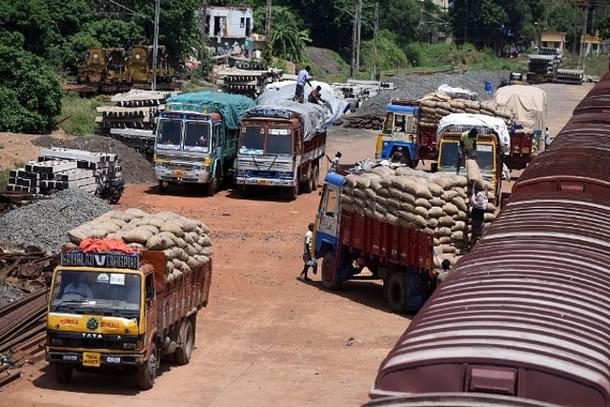Economy
Opposition Boycott Of GST Event Is Hypocrisy, But Underlines Political Risks For Modi From New Tax
R Jagannathan
Jun 30, 2017, 11:51 AM | Updated 11:51 AM IST
Save & read from anywhere!
Bookmark stories for easy access on any device or the Swarajya app.


The boycott by many Opposition parties of the midnight launch of the goods and services tax (GST) underlines the political nature of this new tax, which shifts indirect tax sovereignty from Centre and states to a composite institution called the GST Council.
The Congress, the Trinamool Congress, the Dravida Munnetra Kazhagam, the Bahujan Samaj Party, Akhilesh Yadav’s Samajwadi Party, Lalu Yadav’s Rashtriya Janata Dal, and the Left Front are among those who will stay away, thus indicating the broad contours of the political “mahagathbandhan” that may take shape against the Narendra Modi-led National Democratic Alliance in 2019. Nitish Kumar’s Janata Dal (United) will participate, and so will Deve Gowda’s Janata Dal (Secular), indicating who the fence-sitters of 2019 may be. Gowda will, as a former prime minister, be on the dais, but Manmohan Singh, another former prime minister invited, will be missing due to the Congress boycott.
That the boycott is intensely political and nothing else can be discerned from the nonsensical nature of the objections raised by those who won’t attend.
While Mamata Banerjee rubbished the early launch of GST as an “epic blunder”, the Congress’ objections seem even more laughable. Ghulam Nabi Azad objected to the midnight setting of the event, and claimed that “midnight sitting was held only thrice starting with August 15, 1947. In 1972, a sitting was held to mark silver jubilee; and the third time it was for golden jubilee of our Independence. Maybe, 1947 has no relevance for BJP since they played no role in freedom struggle.”
His colleague Anand Sharma went to even more ridiculous lengths, junking the GST as mere “tax policy”. One would have thought a former commerce minister would know that GST is not just tax policy, but a transformative reform that has the potential for large revenue growth and positive implications for ease of doing business. Sharma said: “This midnight spectacle is ignoring (the) harsh realities of society, intolerance, farmer issues. Congress cannot be party to such a ‘tamasha’…We won’t be party to publicity for a mere tax policy.”
He didn’t pause to ask himself why, if GST was a mere “tax policy,” it needed a constitutional amendment, and nearly 15 years to launch. It’s sour grapes.
However, the point to note is the political import of the GST. By boycotting the event, the Opposition is sending out a clear message that it intends to make political capital out of it as things will surely go wrong in the initial months of implementation.
The Opposition calculates that GST will bring more pain than gain in the initial months, especially as software glitches surface, daily clarifications need to be issued on rules and procedures, and those who must comply with it start small agitations against it. Small businesses and traders will be particularly miffed.
The forecast for GST implementation and its political backlash will run something like this:
July-September 2017: Daily fire-fighting by the government, and a regular stream of changes both to the rules and the rates of GST based on new assessments and lobby pressures. GDP growth will be particularly hit, as both industry and services, and small companies and traders, begin to adjust to the new regime. Revenue growth may be slow, if it does not actually decline, as government focuses more on ironing out problems than in collecting revenues.
During this period, the naysayers will have lots of “I-told-you-so” moments, as government and bureaucracy and software engineers run helter-skelter to get the system up and running.
October-December 2017: This is the time the system will stabilise, and states will start closely monitoring compliance and assessees start facing the heat for non-compliance and underpayment of taxes. Service tax assessees will face unwelcome scrutiny by states – something they didn’t have to face in the past. States will also start raising demands on their revenue flows, which will initially look problematic. The centre will have to dig deep into its pockets and ensure that states get the guaranteed revenue flows.
In this phase, the Opposition will start shouting about slow revenue gains or reimbursements by the centre, even as the centre grapples with growing fiscal deficits. More “we-warned-you” moments for the Opposition to score political points. The Gujarat (and Himachal) elections will happen just in this quarter, and with traders one of the worst affected segments under GST, the Opposition protests will be loudest in this phase. One should not rule out protests by tax authorities at both centre and states, and jurisdictional issues surface.
The chances are the government will adopt a January-December financial year, and we will get a new budget sometime in late October or early November. Expect more political screaming in this quarter.
January-March 2018: This will the quarter where we will finally have visibility on how the multi-tier rate structure (3, 5, 12, 18, 28 per cent, and special luxury goods rates) is working, what its flaws are, and how the GST finally needs to be rejigged. This is when we will know for sure if the early expectations of a revenue surge will materialise quickly, or only after a lag.
With the Karnataka elections due in mid-2018, and with the BJP seeking to wrest the state away from the Congress, the BJP will be particularly vulnerable if GST is seen to be underdelivering on its promise, and issues remain unsettled.
But logically, this is the quarter when the broader approach to GST and course corrections will have to be finalised.
The Opposition, with its boycott, is positioning itself to reap advantage from any mis-steps in implementation, or from any anger generated in any class of businessmen or traders or consumers.
It is a failsafe game to play. If GST works smoothly, the Opposition can quietly abandon its stand and focus on other issues (another cow-related lynching, a terror attack, etc). If GST totters for a while, they will move in to claim vindication, with Modi being held responsible for everything. If the GST cow does not yield milk, Modi will be blamed for his “epic blunder.”
Unlike demonetisation, where the Opposition hope that people inconvenienced by the disruption will vote against the BJP in various state elections was belied, this time the Opposition is hoping for a bumper harvest of voter dissatisfaction over GST.
Modi is treading a minefield, and if he is to navigate it without mishap, he must repeatedly communicate and reassure the people for the next six months.
On past form, one thing can be said: if anybody can ride the storm, it is Modi.
Jagannathan is former Editorial Director, Swarajya. He tweets at @TheJaggi.





